What Is The Principle of Electromagnets : Structure And Use In Our Life , Pros And Cons
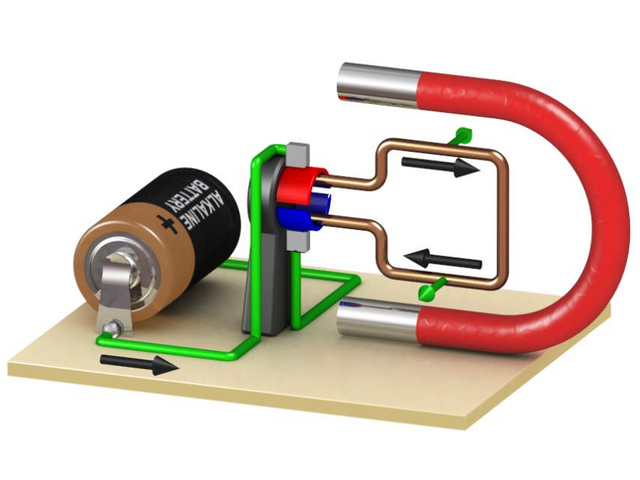
Wherever you look, everywhere - a magnet. Once the schoolchildren were told only about the compass, later - about the use in the industry, recently started talking about the future train on the magnetic suspension. Although it could be said that any electric motor and any transformer is an electromagnet. Today, convincing the reader of the importance of magnets has become easier: it suffices to say that the magnet is almost certainly in his house (on the refrigerator door and in the microwave), in his pocket (in the cell), dozens of magnets in the computer and car. In industry and medicine, they can not be counted at all, and the physics of elementary particles can not do without them-they stand along the entire perimeter of the accelerator ring, and in most of the detectors of elementary particles.
There are permanent magnets, there are electromagnets. Constants have one big plus - they do not consume energy, and a few minuses - their field can not be regulated (and if possible, slowly - mechanically moving), and it can not be very strong. Electromagnets are free from these shortcomings, but they have one that is not available for permanent magnets - they consume energy, and consume much. Sometimes they say that the problem is solved by electromagnets with superconducting windings, as in the Tokamak. But, firstly, neither liquid helium nor liquid nitrogen on the Earth from the lake can be scooped up, and secondly, the magnetic field of such electromagnets is also difficult to regulate.
The idea arises: to cross the electric and magnetic field, to find a substance or create a material, when placing it in an electric field it becomes a magnet, and in a magnetic field, on the contrary, exhibits electrical properties. Such substances are described in an article by AP Pyatakov and AK Zvezdin from the Moscow State University. MV Lomonosov and the General Physics Institute. A. M. Prokhorov.
Variable permanent magnet
Magnetic and electrical phenomena have been known since antiquity, but they were connected much later, after the works of the classics of electromagnetism: Oersted, Ampere, Faraday, Maxwell. Following Ampere, the magnetic properties of permanent magnets were explained by the "molecular" currents flowing inside the substance in each molecule. Although the nature of molecular currents for a long time remained incomprehensible, the very possibility of the perpetual movement of charges inside the substance seemed promising (this possibility is realized in superconductors, but at low temperatures). If an electric field were able to act on molecular currents, then it would be possible to control permanent magnets with practically no loss of energy.
In 1884 the French physicist Pierre Curie suggested that the existence of such molecules and substances that would be magnetized under the action of an electric field does not contradict known laws. American electronics engineer Bernard Tellggen later proposed to create a composite - a magnetoelectric medium in the form of a slurry, where the particles would float, which were magnets linked to pieces of electret. A electret is a substance that can be "charged" by an external electric field, and after this, for a long time, for example years, creates around itself an electric field, like a magnet - a magnetic field. Electrets are many good dielectrics, but materials that combine the properties of both electret and magnet have not been found or created. Although the name for them came up with - "magnetoelectrics."
The matter shifted from a dead center when LD Landau and EM Lifshits pointed out that magnetoelectrics must be sought among antiferromagnets, that is, crystals consisting of oppositely magnetized sublattices (Fig. 1). IE Dzyaloshinsky called in 1959 a specific compound - Cr2O3, and a year later the magnetoelectric effect in this material was discovered by D. N. Astrov. A few years before that, American scientists in the group of Professor George Rado had tried to discover the magnetoelectric properties of various substances, but the search was unsuccessful, since they did not know about the works of Landau, Lifshitz and Dzyaloshinsky - the translations of books and articles were delayed. Learning about the discovery of Astrov, they demonstrated on Cr2O3 and the opposite effect - the electric polarization induced by the magnetic field.
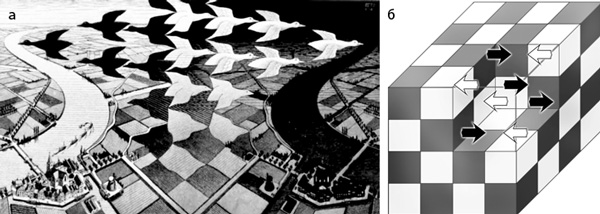
Fig. 1. Antiferromagnetism. The idea of antiferromagnetic ordering was anticipated by Maurice Escher's drawings, for example, "Day and night" (a), in the neighboring nodes of the crystal cell, the magnetic arrows (moments) of the ions are directed oppositely (b)
At the same time, in the Leningrad Physicotechnical Institute, in the group of GA Smolenskii, magnetic ferroelectrics were searched. An ordinary ferroelectric is a substance that, in itself, without the external influence, creates both inside and outside the electric field, that is, in some sense an electrical analogue of a permanent magnet. A magnetic ferroelectric is a material in which, in the absence of external fields, both magnetization and electric polarization would be observed. The replacement of the magnetic elements by ions in already known ferroelectrics was assumed, and the first "ferroelectromagnet" (or "multiferroic", as these materials are now called) turned out to be "compound", it was a solid solution (1-x) Pb (Fe2 / 3W1 / 3) O3 - xPb (Mg1 / 2W1 / 2) O3.
Ferroelectromagnets and multiferroics: terms-chimeras
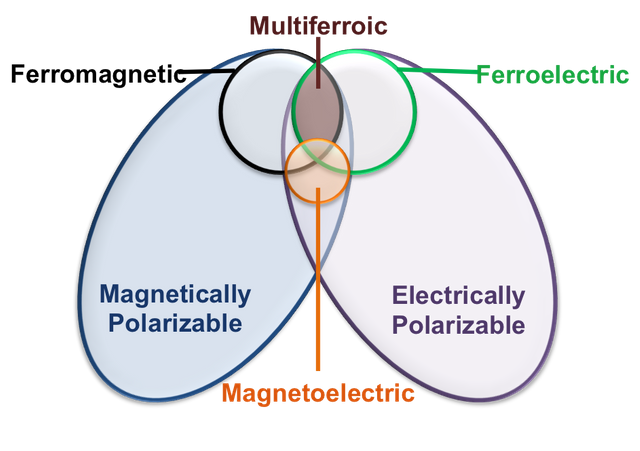
Three classes of ferroics: ferroelectric, magnetic and ferroelastic substances. At the intersection of these sets lie multiferroics
Many familiar words represent a kind of mythological chimera - an animal with a lion's head, a trunk of a goat and a tail of a snake. So the word "bus" was obtained by combining the parts of the words "car" and "omnibus" (from Latin omnibus - to everyone, for everyone). Similarly, the term "ferroelectromagnet" is composed of two words "ferroelectric" and "ferromagnet." The word "ferroelectric" comes from the first discovered substance, in which there is polarization in the absence of an electric field (spontaneous electric polarization), - Rochelle salt, named after the French pharmacist Senignet. And there is another miracle - substances in which, as the temperature is lowered, the crystal, remaining intact, breaks up into domains-regions with different orientations of the crystal lattice (this is called a structural phase transition). Thus, the word "ferroelectromagnet" already represents a rather strange hybrid, but the term "multiferroic" is even more "chimerical".
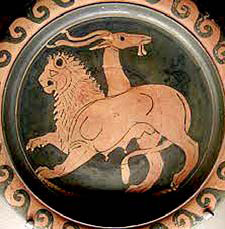
Chimera of ancient mythology
In the English-language scientific literature, the names of all these three classes of substances begin with the prefix "ferro": ferromagnetics, ferroelastics, ferroelectrics, although iron has nothing to do with it. This did not prevent, however, in the middle of the last century, the Japanese scientist Keichiro Aidz, to name all three classes the common term "ferroics" - ferroics. A similar story happened in the English language: a piece from the "omnibus" migrated to the "bus", and then the bus became an independent word, meaning, besides the bus, also a data transmission channel.
In the case of ferroics, the story continued: in the early nineties of the last century a new genie was released from the bottle - the term "multiferroic" (from the Latin multi - many) - to designate a substance that simultaneously belongs to at least two classes of ferroics. At the beginning of this century, when new environments with magnetic and electrical properties appeared, this word unexpectedly quickly gained recognition and supplanted the "ferroelectric", so the very creator of the neologism, the Swiss scientist Hans Schmid, when it comes to the term he invented, recalls the poem by Goethe, a passage from which is given as an epigraph.
Shake or interleave?
Later, more simple compounds were found, and bismuth ferrite BiFeO3 turned out to be especially interesting (Fig. 2). Most of its remarkable properties are due to differences from an ideal cubic structure. Rotation of oxygen octahedra (Figure 2a) leads to the fact that in this antiferromagnet the magnetic arrows of neighboring ions are no longer strictly opposite, forming an angle of less than 180 degrees. As a result, they do not completely compensate each other, and a general magnetization of the crystal appears (such materials are called weak ferromagnets). Electrical and magnetoelectric properties are due to the displacement of ions along the main diagonal of the cube, as well as distortions of the octahedron (Fig. 2b). The bismuth ferrite crystal can also be stretched in the light rays (Figure 2c) and converted into a semiconductor diode under the action of an electric field (Fig. 2d). The last conversion occurs due to oxygen vacancies - charged defects, which change the type of conductivity.
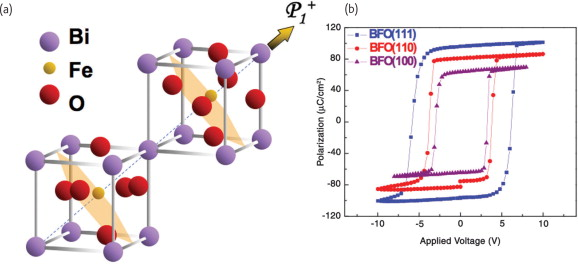
Fig. 2. Crystalline structure of bismuth ferrite: iron ions in the centers of the cubes, bismuth ions in the vertices, oxygen ions in the centers of the faces: rotation of the oxygen octahedra (a), displacement of ions along the diagonal of the cube and the distortion of octahedra-ion displacements caused by them are shown by arrows b), electrostriction in bismuth ferrite - the stretching of the sample under the action of light, under the one-hundred-watt lamp, the relative elongation is about a thousandth of a percent, which is not too small for a solid
Such "high-temperature" magnetoelectrics, like bismuth ferrite, are very few, hardly more than a dozen, and even those have a significant drawback - appreciable conductivity at room temperature. This negates the main advantage of the magnetoelectric method of obtaining a magnetic field - when an electric field is applied, a current will flow in such a substance, which means that the energy consumption becomes noticeable. Therefore, in the 70s of the last century, the first attempts were made to create artificial compositional magnetoelectric media in the form of a mixture of two powders (Fig. 3a): the magnetostrictive particles changed shape in a magnetic field, they acted on the particles of the piezoelectric, and they, in turn, the deformations were electrically polarized.
The idea was wonderful, but the effect was small and unstable. With mixing, lumps and clots were obtained, and the formation of channels from conducting magnetostrictive particles led to a "short circuit" of the sample, and hence to the absence of an electrical voltage. Then came the idea of a "puff cake" or a sandwich made of magnetostrictive and piezoelectric materials glued together (Figure 3b). Conductive channels were no longer formed, and the magnetoelectric effect became 50 times greater than in Cr2O3. With the help of sensors on sandwich structures, it was possible to measure magnetic fields one million times smaller than the field of the Earth-such is our heart creating, distilling the blood through the vessels.
When a structure affects properties
A new stage in the creation of composite materials came with the arrival of modern technologies: now artificial magnetoelectrics are made on chips in the form of films with columnar nanostructures (Figure 3c). Sandwich structures in the nanofilm design work poorly - adhesion to the chip substrate does not allow them to deform freely, and the columns are easily compressed and stretched in a vertical direction. In addition, such structures did not have to be created specially, they "self-organize" with simultaneous deposition of two substances on the substrate: magnetostrictive, for example, spinel CoFe2O4, and piezoelectric, for example BaTiO3 barium titanate or bismuth ferrite BiFeO3. By changing the crystallographic orientation of the substrate, it is possible to grow both magnetostrictive bars in the piezoelectric matrix and piezoelectric bars in the magnetostrictive matrix (Fig. 4).
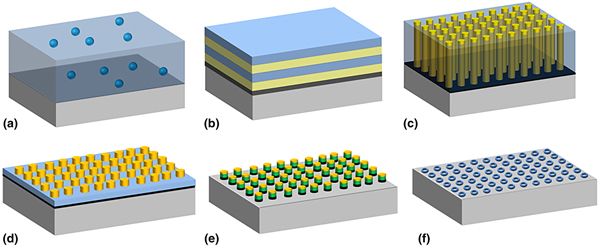
Fig. 4. The structure of the nanocomposite depends on the crystallographic orientation of the substrate plane: a substrate with orientation (001) , a substrate with orientation (111) ; cubes correspond to piezoelectric crystals, octahedra to crystals of magnetostriction material
What makes two phases precipitate in this way? The same phenomenon that causes a drop of water to blur on a clean glass and roll into a ball on the surface, waxed, is surface tension. If the substrate is cut perpendicular to the crystallographic direction [001] (i.e., the z axis of the coordinate system), the substance of the magnetostrictive material does not wet the surface, collecting in droplets, which then grow into bars, while the piezoelectric phase moistens the substrate and envelops the bars to form a matrix . On the substrate (111), everything is reversed: a columnar structure of the piezoelectric is growing inside the magnetostrictive matrix.
When the characteristic dimensions of the nanostructures are several interatomic distances, the phases of the composite begin to influence the internal structure and properties of each other. If the layers of barium titanate are interleaved with a magnetic material with a similar crystal structure, for example, lanthanum manganite with calcium substitution La0.7Ca0.3MnO3, an artificial magnetoelectric medium is obtained: due to the close neighborhood, the crystal structures of the two materials undergo mutual distortions, which leads to the interaction of the electric and magnetic subsystems. That is, it was possible not only to create nanostructured material, but also to carry out engineering at the atomic level, changing the properties of the substance-components themselves.
And what about the original idea of Curie on magnetoelectric molecules? It can be realized in organic molecular nanoclusters Dy3, in which the magnetic atoms are three atoms of dysprosium, forming a regular triangle (Fig. 5). In the state of the molecule with the lowest energy (in the ground state), the magnetic arrows (moments) of dysprosium ions are oriented parallel to the opposite side of the triangle (Fig. 5). If there were more magnetic ions (as, for example, in the newly synthesized Dy6 cluster), they would form a "carousel" of magnetic moments (Fig. 5). Such an ordering is called "toroidal", since a circular electromagnet can be created by winding a wire onto a magnetic core in the form of a donut (torus). Structures with toroidal ordering, following the tradition of denoting any ordering by the word "ferro", are called "ferrotoroids". They have a magnetoelectric effect - application of a magnetic field causes redistribution of magnetic moments: the number of ions in which magnetic moments are directed along the magnetic field increases. The displacement of magnetic ions entails a redistribution of charges, so that an electric polarization arises. However, the states of the molecule in which the magnetic moments are directed clockwise and the states with the direction of the moments counterclockwise are realized with equal probability, and in these cases the magnetoelectric effect will be opposite. So there remains the problem of how to obtain toroidal structures with one direction of rotation of magnetic moments.
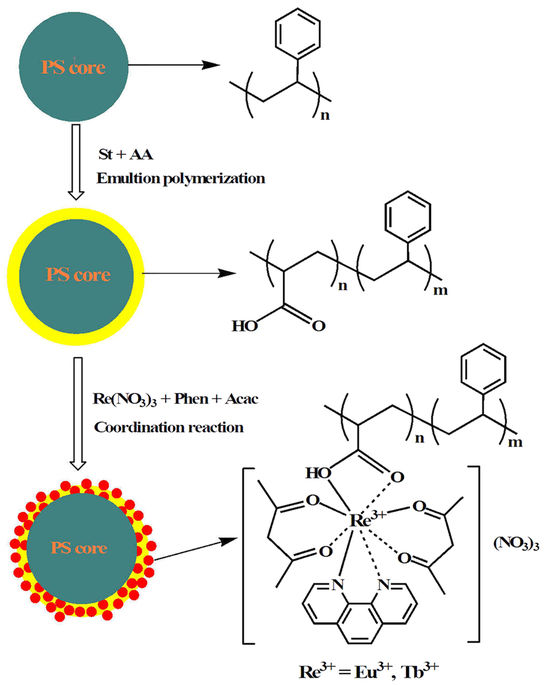
Fig 5. Organic molecular nanoclusters based on rare-earth ions: mutual orientation of the magnetic moments of dysprosium cations
Memory does not work from the monitor
Tellegen's idea of a composite composed of magnetoelectric particles that rotate in a liquid was realized with the advent of the first model of electronic ink, the gyricon (from the Greek "rotating image"). Gyrikon is a polymeric medium into which two-color spherical particles of polyethylene are introduced rotating inside the cavities with liquid (Figure 6). The hemispheres of the particle differed not only in color, but also in electric charge. Therefore, they could be oriented by applying an electric field, and black letters appeared on a white background. When magnetic particles were introduced into the particles, the electric field began to control the magnetization of the system. However, the rotation took about a second, so the idea arose to "magnetize" not electronic paper, but the main component of another type of displays - liquid crystals.
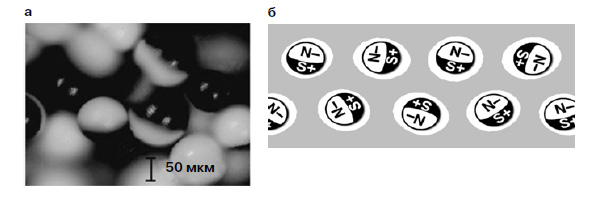
Fig. 6. Gyrikon: a polymer with embedded black and white spherical particles (a), a magnetoelectric composite based on a gyricon: dipole particles rotate in micro cavities with a liquid. +/- electric, S, N - magnetic poles (b)
In liquid crystals of nematic (from the Greek "thread") elongated molecules are located along one direction (Fig. 7a). Liquid crystal monitors work because of the property of the nematic molecules to orient themselves along the field (Fig. 7b), but if magnetic nano-bars are added to the liquid crystal, they will rotate together with the molecules. A magnetic material was obtained, controlled by an electric field, and it responded to the change in the electric field much more quickly - the switching frequency was kHz.
This is faster, but the gyric and liquid crystal cells can not compete with the elements of semiconductor chips in terms of both size and speed, which means they are not suitable for magnetic memory devices. Instead of a liquid crystal, a layer of a solid-state magnetoelectric was proposed to be placed between the electrodes in the magnetic memory devices, but because of the small number of high-temperature magnetoelectrics and high leakage currents, the magnetoelectric memory is still far from being realized.
"Clever dust" collects energy
Miniaturization of electronic devices is the way to create wireless sensor networks consisting of a set of sensors capable of collecting, processing information and exchanging information among themselves. Such structures are sometimes called "smart dust". The most obvious applications are environmental and medical monitoring, security systems. But the sensors need power, and with it the problem: if the sensor is inside the object (for example, in a rotating part or in the body of a person), then the wire can not fail, the batteries are not sufficiently miniaturized and durable, and solar batteries are useless in the dark.
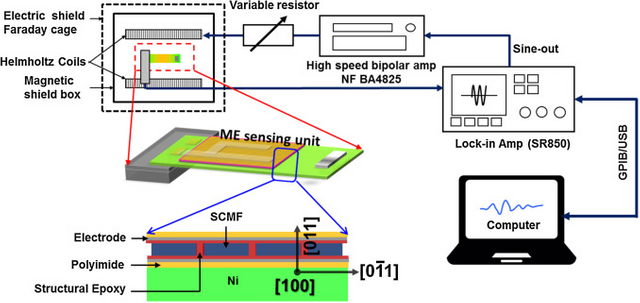
Fig. 8. Remote power supply of sensors: a magnetoelectric transducer based on piezoelectric and magnetostrictive materials located on a substrate of a tapering metal plate - a waveguide acoustic concentrator , a node of a wireless sensor network with a magnetoelectric power supply
An interesting alternative is energy harvesting - obtaining energy from the environment. It can be systems that accumulate energy of mechanical, temperature oscillations or radio waves, but the energy flow coming from natural sources is small - less than 1 μW / cm2. However, it is possible to create a radiation source creating an alternating magnetic field at the location of the sensors. Transform the energy of the magnetic field into the electrostatic energy of charged capacitors by using a magnetoelectric element, which consists of layers of magnetostrictive and piezoelectric materials located on a common metal substrate in the form of a tapered one end of the plate (Fig. 8). An alternating magnetic field causes a periodic deformation of the magnetostrictive plate at the resonant frequency. These mechanical vibrations are transmitted to the substrate and propagate along it, so that when approaching the narrow end, the concentration of acoustic energy and the amplitude of the oscillations increase. The vibrations of the substrate are transferred to piezoelectric plates, and an alternating electric voltage arises in them. This design is a kind of magnetoelectric composite material, but with the help of an acoustic concentrator it is possible to obtain a gain twice as compared to a traditional multilayer structure of bonded magnetic and piezoelectric layers.
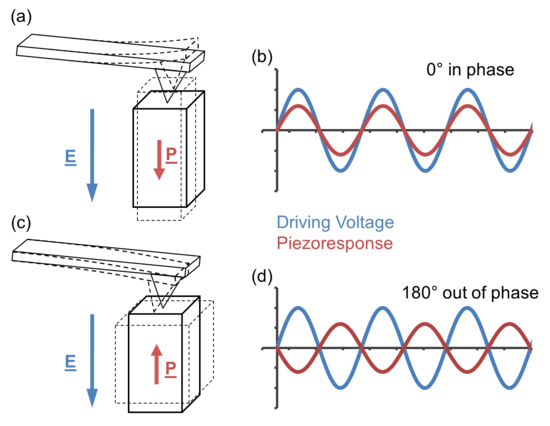
Fig. 9. Mechanical oscillations of cantilever from piezoelectric material: converted into electrical energy
To power implants in medicine, autonomous sensors, as well as communications and mobile electronics, it is better to use mechanical motion or vibration, for example, vibrations of an elastic plate (in modern micromechanics and nanotechnologies such plates are called cantilevers) made of piezoelectric material (Fig. 9a). When a cantilever made of a magnetoelectric composite material oscillates in the Earth's magnetic field, the magnetostrictive layer undergoes additional deformations that are transmitted to the piezoelectric layer, and as a result, the amplitude of the alternating voltage reaches ten volts. Such a device is proposed for use on underwater vehicles and buoys, where there are always ocean waves and the Earth's magnetic field.
Here we need to make one more remark: the frequencies of oscillations occurring in natural conditions are small - hertz, a maximum of tens of hertz. This means, on the one hand, the low power produced by the unit (power is proportional to the cube of the frequency), on the other hand, it is not the microscopic dimensions of devices that can vibrate at these low frequencies. As a result, the chargers give only microwatts in terms of cubic centimeter. The best results are expected from using other types of oscillatory motion: the human body during walking (the piezoelements located in the boot (Fig. 9b) already allow to receive up to 1 mW / cm3) and even more high-frequency vibrations of the motor of the car - up to 30 mW / cm3. But in any case, it is not yet a question of replacing batteries in cell phones. The very harvest of energy harvesting ("energy harvesting") is reminiscent of the well-known process of "scraping along the barns, using the barns", and this explains why in such cases a different term is often used: "energy scavenging" (scavenging - cleaning, recycling of garbage).
The problem of the interconnection between magnetic and electrical phenomena in a solid is extremely multifaceted, and this article shows only some of its aspects. This area of science is now actively developing, there remain many incomprehensible, and unknown effects are waiting for their discoverers.

References for Text and Images:
- https://www.miniphysics.com/principles-of-electromagnetic-induction.html
- https://nanoscalereslett.springeropen.com/articles/10.1186/s11671-015-1139-1
- http://trendintech.com/2016/07/01/scientists-working-hard-with-these-4-newly-discovered-materials/multiferroic/
- http://www.mdpi.com/1996-1944/11/1/24
- https://www.researchgate.net/figure/a-Schematic-of-the-crystal-structure-of-BFO-and-the-ferroelectric-polarization-arrow_216566234_fig4
- https://www.researchgate.net/figure/a-Schematic-of-the-crystal-structure-of-BFO-and-the-ferroelectric-polarization-arrow_216566234_fig4
- https://catalog.flatworldknowledge.com/bookhub/4309?e=averill_1.0-ch06_s01
*steemSTEM
Want to discover more science and technology related content on Steemit? Follow @steemSTEM to see a weekly selection of quality science posts, as well as STEM-related contests. Are you interested in writing posts on related topics yourself? Make sure to join the steemSTEM channel on steemit.chat to engage with other scientists on steemit!

This post has received a 1.13% upvote from thanks to: @pario.
thanks to: @pario.
For more information, click here!!!!
Send minimum 0.100 SBD to bid for votes.
The Minnowhelper team is still looking for investors (Minimum 10 SP), if you are interested in this, read the conditions of how to invest click here!!!
ROI Calculator for Investors click here!!!
This post has received a 0.39 % upvote from @booster thanks to: @pario.